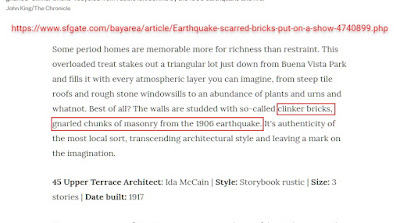This First Chinese Baptist Church stood unique among all Chinatown buildings in that it incorporates clinker bricks in its facade. Originally built in 1888, it was rebuilt after the 1906 Earthquake and fire. The congregation, with assistance from other Baptist churches across the US, was able to rebuild, and they chose a very western choice: walls studded with that's known as "clinker bricks". These bricks are darker, and gnarled, and are named for the sound they make when you clink them together.
 |
First Chinese Baptist Church, 15 Waverly Pl, SF CA 94108
courtesy author |
 |
| Close-up of the gnarled clinker bricks among regular bricks |
Clinker bricks are made by exposing unfired bricks to hotter fire for longer so the surfaces sintered and thus are SEALED, unlike regular bricks which are porous. Therefore, the clinker bricks barely absorb any water, and are denser and heavier than regular bricks, thus more stable.
Yet others passed on an even bleaker version of events:
For now, I'll just say it is POSSIBLE that some of these bricks were reclaimed from the rubble, but we have no definitive proof that this was indeed the case. ENDNOTE
The church served an important function at a time: Chinese children in the 1870s and on were PROHIBITED from attending public schools, even if they were born in the US and grew up in an English-speaking household. We will explore this in length later in a post discussing this landmark legal victory for the Chinese later. But basically, the church operated a "day school" for all the Chinese children in the area.
Indeed, Dr. Hartwell, founder of the church, started helping his congregation in Chinatown back in 1880. He rented a few places to teach English and other skills, while fundraise enough money to buy a lot for the church he planned in Chinatown and built it. It took him six years, then 2 more years to build it. When it was destroyed in the 1906 Earthquake and fire, other Baptist churches around the country and the Home Mission helped him rebuild quickly.
Today, the church is still serving Chinatown, as a symbol of compassion, survival, and resilience.



Comments
Post a Comment